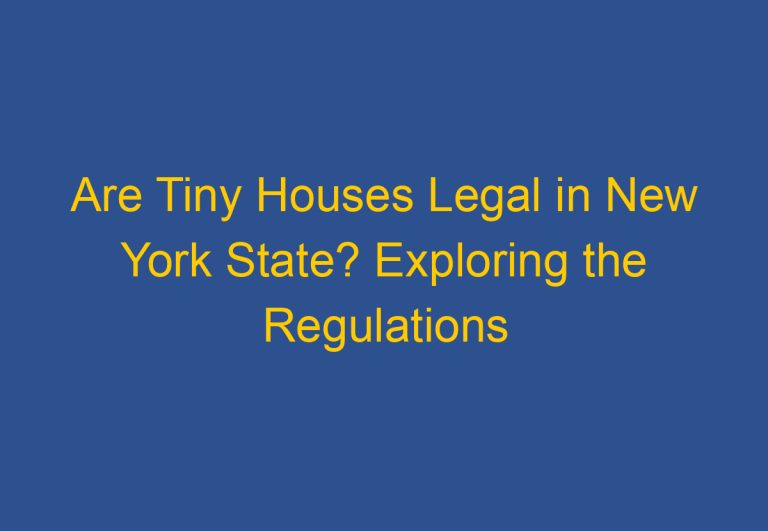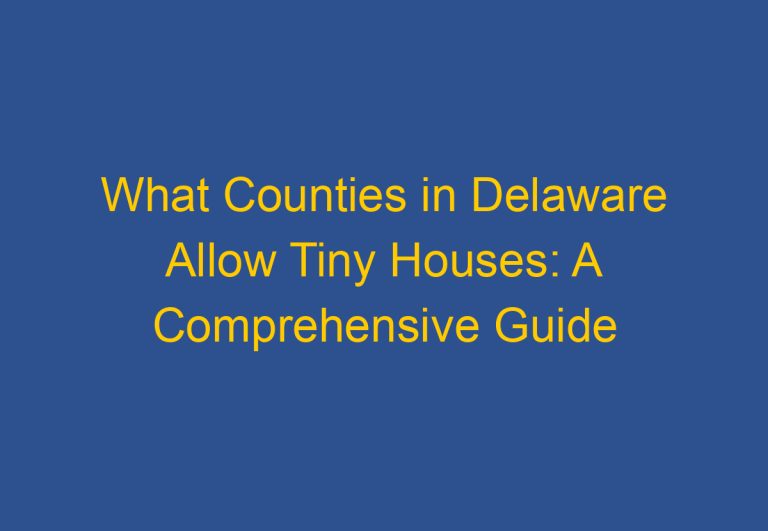Where Can You Put a Tiny House in California: A Comprehensive Guide
Tiny houses have become increasingly popular in recent years, as people look for more affordable and sustainable housing options. However, finding a place to put a tiny house can be a challenge, especially in California, where there are strict regulations and zoning laws. If you are considering building or buying a tiny house in California, it is important to know where you can legally park or place it.
According to the California Building Standards Commission (CBSC), tiny homes must meet certain standards to be considered legal. These standards include a minimum ceiling height of 7 feet 6 inches, at least one room with a gross floor area of 120 square feet, and compliance with local zoning laws. Some counties in California, such as Fresno, Los Angeles, and San Diego, have specific regulations and zoning laws that allow for the building and placement of tiny houses. However, it is important to check with each county’s planning department to ensure compliance with local rules before building.
One option for those looking to live in a tiny house in California is to join a tiny house community. These communities offer a supportive and like-minded community of people who are also interested in tiny living. For example, the Tiny House Block in Mount Laguna is Southern California’s first legal tiny house village, which offers short-term and long-term rentals. It is important to research and find a community that fits your needs and budget, as well as complies with local regulations.
Legality and Zoning for Tiny Houses in California
Understanding California Building and Safety Standards
If you are planning to build a tiny house in California, it is important to ensure that it meets the standards set by the California Building Standards Commission (CBSC). According to the California State Building Code (CSBC), tiny houses must have a ceiling height of at least 7 feet 6 inches and there must be at least one room with a gross floor area of 120 square feet or more. Additionally, tiny homes sold, rented, leased, or occupied within California are only legal if they are built on a chassis with axles, contain 400 sq feet or less of gross floor area, and are considered an RV, CC, or PT.
Navigating Zoning Laws and Local Regulations
Several counties in California allow tiny houses, including Fresno, Los Angeles, and San Diego. However, it is important to check with each county’s planning department to ensure compliance with local rules before building. Zoning laws and local regulations vary by county, and it is essential to understand the zoning ordinance, zoning laws, zoning variances, land use regulations, and development standards in your area.
In addition, it is crucial to obtain the necessary permits and approvals before beginning construction. Failure to comply with zoning laws and local regulations can result in legal troubles, fines, and even the demolition of the tiny house.
Tiny House Communities and RV Parks
Another option for those looking to live in a tiny house in California is to join a tiny house community or park in an RV park. Many tiny house communities and RV parks offer utilities, parking spaces, and other amenities that can make living in a tiny house more comfortable.
However, it is important to note that some tiny house communities and RV parks may have specific rules and regulations that must be followed. It is essential to research and understand the rules and regulations of each community or park before moving in.
Overall, while there are regulations and laws that must be followed when building and living in a tiny house in California, it is possible to do so legally and comfortably. By understanding the California Building and Safety Standards and navigating zoning laws and local regulations, individuals can build and live in their dream tiny home.
Placement and Living in Tiny Houses
Options for Tiny House Placement
When it comes to tiny house placement in California, there are several options available. One option is to place the tiny house in a backyard as an Accessory Dwelling Unit (ADU). However, it is important to note that not all cities and counties allow ADUs. Additionally, there may be minimum lot size requirements, setbacks, and other building and safety standards that must be met.
Another option is to place the tiny house in a tiny home community. These communities are becoming more popular in California and offer a sense of community and shared resources. However, it is important to check with the community’s policies and development code to ensure compliance with local rules.
Building Codes and Property Standards
When building or placing a tiny house in California, it is important to ensure that it meets the California Building Standards Code. Tiny homes must have a ceiling height of at least 7 feet 6 inches and at least one room with a gross floor area of 120 square feet. Additionally, the tiny house must have emergency exits, proper ventilation, and plumbing.
If the tiny house is on wheels, it may be considered a recreational vehicle and subject to different building and safety standards. It is important to consult with a land use attorney or code enforcement officer to ensure compliance with local rules and regulations.
Utilities and Accessibility
When living in a tiny house in California, it is important to consider utilities and accessibility. Many tiny homes are designed to be off-grid and self-sufficient, but it is still important to have access to private parking and utilities such as water, electricity, and sewage.
It is also important to consider accessibility for those with disabilities. California law requires that all new construction be accessible to those with disabilities, including tiny homes. This means that the tiny home must have proper accessibility features such as ramps and wider doorways.
Overall, while there are many options for placing and living in a tiny house in California, it is important to ensure compliance with local rules and regulations. Consulting with a land use attorney or code enforcement officer can help navigate the process and avoid fines or other penalties.
Frequently Asked Questions
What are the zoning requirements for placing a tiny house in California?
Zoning requirements for tiny houses in California vary by county. Some counties have specific regulations and zoning laws that allow for the building and placement of tiny houses, while others do not. It is important to check with each county’s planning department to ensure compliance with local rules before building.
Which California counties have the most lenient regulations for tiny houses?
Several counties in California allow tiny houses, including Fresno, Los Angeles, and San Diego. According to Appendix Q, these counties have specific regulations and zoning laws that allow for the building and placement of tiny houses. However, it is important to check with each county’s planning department to ensure compliance with local rules before building.
Are there specific building codes for tiny houses in California?
Yes, there are specific building codes for tiny houses in California. The California Building Standards Commission (CBSC) has set standards for tiny homes, including a requirement for a ceiling height of at least 7 feet 6 inches and at least one room with a gross floor area of 120 square feet. Tiny homes must also be built on a chassis with axles and contain 400 square feet or less of gross floor area.
How does one obtain a permit for a tiny house in California?
To obtain a permit for a tiny house in California, one must first ensure that the tiny house meets the standards set by the California Building Standards Commission (CBSC). After ensuring compliance, one can then apply for a building permit through the local building department. It is important to note that the process for obtaining a permit may vary by county.
Can tiny houses be legally placed in residential backyards in California?
The legality of placing a tiny house in a residential backyard in California varies by county. In some counties, it may be legal to place a tiny house in a residential backyard as an accessory dwelling unit (ADU), while in others it may not be allowed. It is important to check with each county’s planning department to ensure compliance with local rules before building.
What are the options for legally parking a tiny house in California?
The options for legally parking a tiny house in California vary by county. Some counties allow tiny houses to be parked in RV parks, while others allow them to be parked on private property as long as they meet certain requirements. It is important to check with each county’s planning department to ensure compliance with local rules before parking a tiny house.










